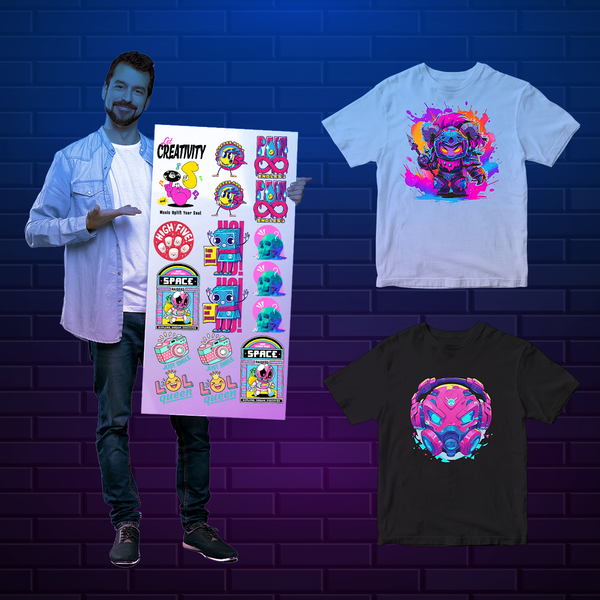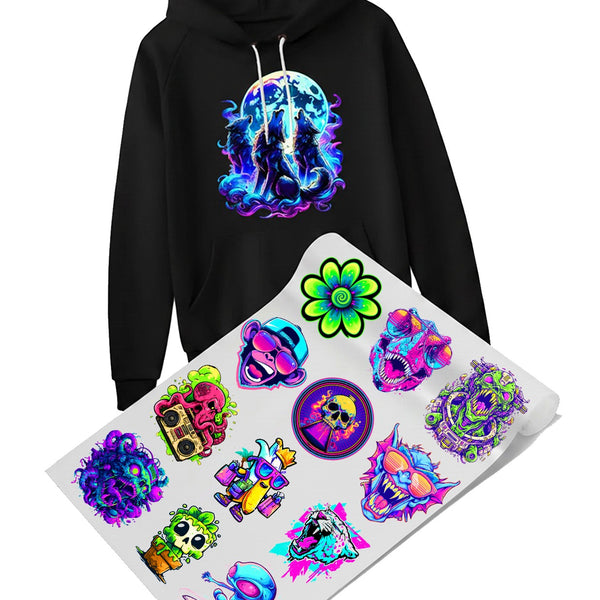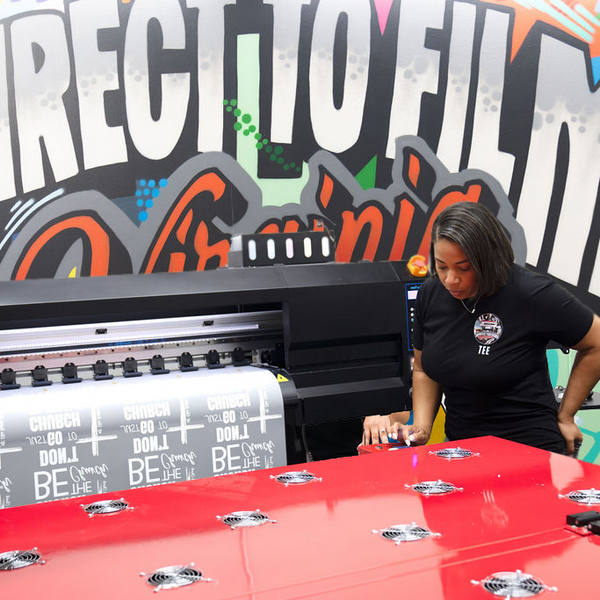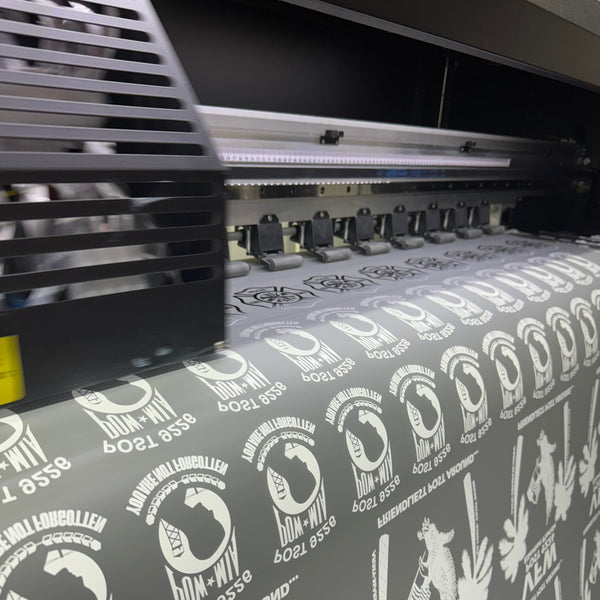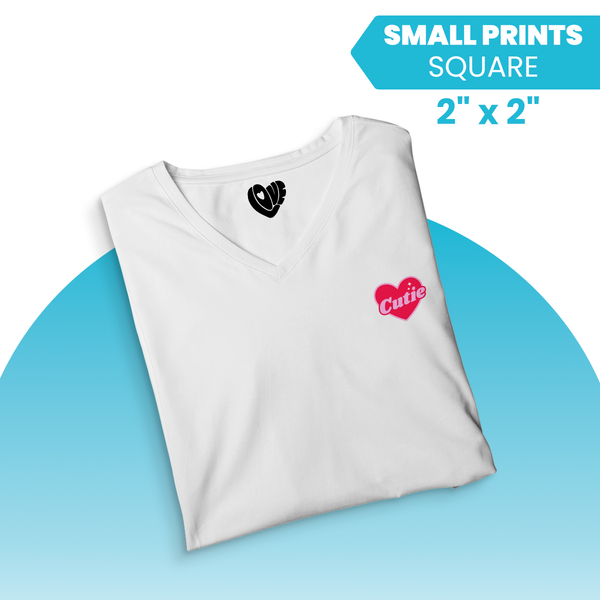DTF RVA transfers are significantly changing how custom apparel is made in Richmond, Virginia. These advanced heat transfers bring a level of durability and versatility that older methods often cannot match. If you are looking into this impressive printing technology, you are in the correct spot.
We will explore direct-to-film (DTF) transfers and discover why they are rapidly becoming a favorite in RVA. This guide will cover everything, from the fundamental principles to expert advice for maximizing your DTF prints. Understanding DTF can help you make informed decisions for your apparel projects.
What Are DTF RVA Transfers?
DTF transfers represent a modern technique for applying designs to various fabrics. The method involves printing your chosen design onto a specialized film, which is then transferred to your garment using a heat press. This innovative technique is effective on a broad spectrum of materials, including popular choices like cotton, polyester, and blends thereof.
In Richmond, VA, these DTF transfers are gaining widespread popularity among local enterprises and creative individuals. They present an accessible way to produce high-quality dtf, long-lasting custom apparel without incurring excessive costs. The flexibility of dtf printing allows for intricate, full-color designs with relative ease compared to other methods.
The "direct-to-film" aspect means the design is first rendered on a transfer film before it ever touches the garment. This intermediate step is crucial for achieving vibrant colors on dark fabrics, a common challenge for other printing types. This dtf technology is particularly beneficial for businesses in Richmond needing reliable and striking branding solutions for their apparel.
The Advantages of DTF RVA Transfers
Why are so many individuals and businesses in Richmond, and indeed across the transfers USA market, gravitating towards DTF transfers? The reasons are compelling and varied, highlighting the practical benefits of this method. Let's look at some primary advantages you can expect when you choose options involving dtf transfers online.
The following points underscore why this technology is a preferred choice for creating custom apparel:
- Durability: DTF prints are known for their resilience. They can endure numerous wash cycles without showing significant signs of fading, cracking, or peeling, making them ideal for everyday wear and frequently laundered items. This durability often surpasses that of traditional heat transfers.
- Versatility: A major strength of DTF is its adaptability. These transfers work exceptionally well on both light and dark colored fabrics, and can be applied to cotton, polyester, nylon, leather, and various blends. This broad compatibility makes them a versatile solution for diverse apparel needs.
- Vibrant Colors: DTF technology, particularly when using quality ink, excels at producing bright, vivid, and eye-catching designs. The process often involves a white ink underbase, allowing for excellent color saturation and opacity, even on the darkest materials. Expect truly vibrant results with your custom dtf projects.
- Cost-Effective: For small to medium-sized production runs, DTF can be notably more affordable than methods like screen printing. There are lower setup costs involved, making it an economical choice for startups, small businesses, or individuals needing limited quantities of custom garments. This makes affordable dtf transfers a reality.
- Quick Turnaround: The DTF process is generally faster from start to finish compared to some other methods, especially for complex multi-color designs. This can lead to quicker production times and fast shipping, which is a significant benefit for time-sensitive orders.
- Soft Hand Feel: Unlike some traditional transfer methods that can leave a thick, plastic-like feel on the garment, DTF transfers typically offer a softer hand. The print integrates well with the fabric, leading to a more comfortable wearing experience, especially on thinner garments.
- Fine Detail Capability: DTF printing can accurately reproduce intricate details and fine lines in a design. This makes it suitable for complex graphics, photographic images, and text-heavy artwork, providing high-quality dtf transfers that are crisp and clear.
These benefits make DTF transfers a leading option for RVA businesses and individuals who want to create unique and professional custom apparel. They provide high-quality results that meet modern demands. Many suppliers offer high-quality materials to support this process.
How DTF RVA Transfers Work
Understanding the mechanics behind the DTF process can enhance your appreciation for the quality and consistency of these transfers. The creation of a dtf transfer involves several key stages, each contributing to the final high-quality print. Here's a more detailed breakdown of this innovative dtf technology:
- Design Creation & Preparation: The journey begins with your artwork. Designs are typically prepared digitally using graphic design software such as Adobe Illustrator or CorelDRAW for vector graphics, or Adobe Photoshop for raster images. For optimal results, high-resolution artwork (ideally 300 DPI at the final print size) with a transparent background is crucial.
- RIP Software Processing: Before printing, the design is processed through Raster Image Processor (RIP) software. This software is vital for DTF, as it handles color management, white ink generation (for printing on dark garments), and ink laydown control, optimizing the print for the transfer process.
- Printing onto PET Film: The processed design is then printed onto a special Polyethylene Terephthalate (PET) film. This isn't just any film; it's specifically coated for DTF applications. The printing is done using a dedicated DTF printer equipped with specialized water-based pigment inks, typically in a CMYK plus White configuration. The design is printed in reverse (mirrored image) on the film, with the color layer printed first, followed by a white ink layer on top.
- Adhesive Powder Application: Immediately after printing, while the ink is still wet, a fine thermoplastic polyurethane (TPU) adhesive powder is applied evenly over the printed design. This powder sticks only to the inked areas. Excess powder is then removed, often by shaking or using an automated powder shaker.
- Curing the Print and Adhesive: The PET film with the inked and powdered design then goes through a curing process. This usually involves heating it in an oven or under a heat press platen (without direct contact) at a specific temperature (typically around 250-320°F or 120-160°C) for a set duration. This step melts the adhesive powder, bonding it to the ink and creating a smooth, pliable layer. The cured design is now a ready-to-apply dtf transfer.
- Transfer to Garment: The final step is to apply dtf transfers to the fabric. The PET film carrying the cured design is placed onto the garment in the desired position. Using a heat press, heat and pressure are applied according to specific pressing instructions (typically 280-320°F or 140-160°C for 10-20 seconds, but this varies by material and transfer type).
- Peel and Finish: After pressing, the PET film is peeled away, usually after it has cooled (cold peel) or sometimes while still warm (warm peel), depending on the specific film and adhesive used. This leaves the ink and adhesive layer bonded to the fabric. A brief second press (post-press) for a few seconds, often with a finishing sheet, can improve durability and feel.
This systematic process results in a durable, flexible, and high-quality print that integrates beautifully with the fabric. It's what makes easy-to-apply direct-to-film transfers so appealing for custom apparel.
DTF vs. Other Printing Methods in RVA
To fully grasp the value that DTF RVA transfers bring, it's useful to compare them with other common printing methods available in Richmond. Each technique has its strengths, but DTF often provides a compelling balance of quality, versatility, and cost for many applications. Understanding these differences can help you decide if you want to buy dtf or stick with older methods for your custom apparel needs.
DTF vs. Screen Printing
Screen printing has been a cornerstone of the custom apparel industry for decades, particularly favored for large volume orders. It involves creating a stencil (screen) for each color in the design and pushing ink through the stencil onto the fabric. While excellent for high-volume jobs with simple graphics due to its cost-effectiveness at scale and durability, screen printing has higher setup costs and longer setup times. This makes it less economical for small batches or designs with many colors, where each color adds to the cost and complexity. DTF, in contrast, excels with full-color, complex designs even in small quantities, without the extensive setup per color, offering more affordable dtf solutions for such projects.
DTF vs. DTG (Direct-to-Garment)
Direct-to-Garment (DTG) printing is another digital method where inks are sprayed directly onto the fabric by a specialized printer. DTG can produce high-quality, full-color prints with a soft feel, especially on 100% cotton garments. However, DTG typically requires pre-treatment for dark-colored garments to ensure color vibrancy and wash fastness, which adds a step and cost. It's primarily suited for natural fibers like cotton and can struggle with polyester or blends. DTF transfers, on the other hand, do not require pre-treatment of the garment itself (the film handles the base) and work effectively on a wider array of materials, including cotton, polyester, blends, and even some hard surfaces when using uv dtf variations. This makes DTF more versatile across different types of custom apparel.
DTF vs. Vinyl Heat Transfer (HTV)
Vinyl heat transfers (HTV) involve cutting designs from colored vinyl sheets and then heat-applying them to garments. HTV is popular for simple, one or two-color designs, names, and numbers, especially in sportswear. It's durable and available in various finishes (glitter, metallic, flock). However, HTV can feel thicker and less breathable on the garment, especially for larger designs. Complex, multi-color designs require layering multiple pieces of vinyl, which can become bulky and time-consuming. DTF transfers are generally thinner, more breathable, and can handle intricate, full-color designs in a single application, offering a more premium feel for detailed graphics. These heat transfers provide a more integrated appearance.
DTF vs. Sublimation Printing
Sublimation printing produces incredibly vibrant, permanent prints with an undetectable feel because the ink becomes part of the fabric. However, sublimation has significant limitations: it only works on white or very light-colored polyester fabrics (or polyester-coated hard surfaces). It cannot print on cotton or dark-colored materials because sublimation ink is transparent and needs the white background of the substrate to show true colors. DTF printing overcomes these limitations, allowing for vibrant prints on cotton, polyester, blends, and both light and dark fabrics, providing far greater flexibility in garment choice for those wanting high-quality dtf transfers.
Understanding DTF Gang Sheets
A gang sheet is a game-changer for anyone looking to buy dtf transfers efficiently and affordably. Essentially, a dtf gang sheet allows you to print multiple designs, or multiple copies of the same design, on a single large sheet of DTF film. This practice maximizes the use of the film and printer capabilities, leading to significant cost savings, especially when you order transfers in bulk or have many smaller logos or graphics.
Businesses and individuals creating custom dtf designs can benefit immensely from dtf gang sheets. Instead of paying for each small transfer individually, you pay for the entire sheet, fitting as many designs as possible within its dimensions. This approach is particularly useful for clothing brands needing various sized logos, tagless labels, and small decorative elements, or for individuals creating multiple T-shirts with different graphics for an event. The use of a dtf gang helps make even complex projects more manageable and cost-effective.
Many suppliers who offer high-quality DTF printing services also provide an online gang sheet builder or sheet builder. These tools simplify the process of arranging your designs on a custom dtf gang sheet online. You can upload your artwork, scale it, duplicate it, and arrange everything optimally to make the most of the available space. Ordering a gang sheet online is a convenient way to get affordable dtf transfers online without compromising on the highest quality prints. This makes the production of custom dtf gang sheets a popular choice.
Utilizing gang sheets is a smart strategy for achieving cost-effective direct-to-film printing. Whether you're a small business looking to produce merchandise or a hobbyist working on personal projects, custom gang sheets help you get more for your money. The efficiency of a custom dtf gang reduces waste and lowers the per-unit cost of each transfer, making it an attractive option when purchasing transfers online.
Getting Started with DTF RVA Transfers

Are you ready to try dtf transfers for your next project in Richmond, VA? Embarking on your first dtf transfer project can be exciting. Here are some practical tips to help you get started and ensure you achieve the highest quality results for your custom apparel.
- Find a Reputable Printer: Search for rva dtf transfers providers or explore options to buy dtf transfers usa from reputable online sellers. Look for businesses specializing in high-quality dtf transfers. Check online reviews, ask for samples to assess their print quality, and inquire about their turnaround times and if they offer fast shipping or local day pickup, perhaps at a convenient location like Willow Lawn or similar RVA spots.
- Prepare Your Design Files: For the best custom dtf results, your artwork needs to be properly prepared. Most printers prefer vector files (AI, EPS, PDF) as they can be scaled without loss of quality. If using raster images (PNG, TIFF), ensure they are high-resolution (300 DPI at the final print size) and have a transparent background. Clear artwork is key to a great dtf printing outcome.
- Choose Your Garment Wisely: While dtf transfers are versatile and work on many fabrics (cotton, polyester, blends, leather, nylon), the material can influence the final look and feel. Discuss your garment choices with your printer. Some premium materials might yield slightly different results, so testing on a sample piece is always a good idea, especially for large orders.
- Consider Order Quantity and Gang Sheets: DTF RVA transfers are excellent for small to medium runs. If you have many different small designs or need multiple copies, consider ordering a custom dtf gang sheet to make your purchase more affordable dtf. For very large bulk orders of a single design, traditional screen printing might sometimes be more economical, so discuss options with your printer.
- Understand Pricing: When you buy dtf, pricing can vary based on the size of the transfer, the quantity ordered, and whether you're using a gang sheet online. Some providers might show usd loading indicators as prices are calculated on their websites. Always get a clear quote before you start shopping or order transfers.
- Inquire about Pressing Instructions: Each dtf transfer may come with specific pressing instructions regarding temperature, pressure, and duration for the heat press. These instructions are vital to properly apply dtf transfers. Request these details from your supplier to ensure successful application and vibrant, long-lasting results.
Taking these steps will help you navigate the process of obtaining and using transfers custom to your needs. Whether you opt for local rva dtf services or transfers online, careful planning leads to better outcomes.
Applying Your DTF Transfers Effectively
Once you've received your dtf transfers, applying them correctly is essential for achieving that professional, durable finish. While the process is straightforward, attention to detail makes all the difference. Here's how to apply dtf transfers using a heat press for results that are truly press vibrant.
First, pre-press your garment for 5-10 seconds. This removes moisture and wrinkles, creating a smooth surface for the transfer. Allow the garment to cool slightly before placing the dtf transfer. Position the transfer carefully, ensuring it's straight and centered as desired.
Set your heat press to the recommended temperature and pressure according to the pressing instructions provided by your dtf transfers usa supplier. Typically, temperatures range from 280°F to 320°F (138°C to 160°C) with medium pressure, for 10-20 seconds. Once pressed, follow the instructions for peeling the film—some are cold peel (wait until completely cool), while others are warm or hot peel. Peeling at the wrong temperature can affect the transfer quality. After peeling, it's often recommended to do a short post-press (2-5 seconds) with a Teflon sheet or parchment paper over the design to enhance durability and improve the feel. This makes the heat press vibrant design even more integrated into the fabric. Adhering to these steps will help you get the most out of your easy-to-apply direct-to-film transfers.
Caring for DTF Printed Garments
To maintain the vibrant look and longevity of your DTF RVA transfers and custom apparel, proper care is important. Following a few simple garment care guidelines can significantly extend the life of the print. This ensures your investment in high-quality dtf continues to look great wash after wash.
- Wait Before First Wash: Allow at least 24-48 hours after applying the dtf transfer before washing the garment. This period allows the adhesive to fully cure and bond with the fabric.
- Turn Garment Inside Out: Before washing, always turn the garment inside out. This minimizes friction on the printed surface during the wash cycle, protecting the quality ink and design from abrasion.
- Use Cold Water: Wash DTF printed garments in cold or cool water. Hot water can potentially weaken the adhesive over time and may cause colors to fade prematurely.
- Gentle Cycle Recommended: Opt for a gentle or delicate wash cycle on your washing machine. This reduces stress on the fabric and the print.
- Mild Detergent: Use a mild detergent. Avoid using bleach, fabric softeners, or harsh chemical cleaners, as these can degrade the print quality and affect the premium materials of the transfer.
- Avoid Overloading the Washer: Washing too many items at once can increase friction and potentially damage the print. Give your garments some room.
- Drying Instructions: It's best to air dry DTF printed garments by hanging them or laying them flat. If using a dryer, choose a low heat setting or tumble dry on delicate. High heat can damage the transfer.
- Ironing: If you need to iron the garment, turn it inside out and use a low heat setting. Never iron directly over the DTF print. You can place a cloth over the print area on the inside if needed.
By following these care instructions, your dtf transfers will remain crisp, colorful, and intact for a long time. Proper care preserves the highest quality appearance of your customized items.
The Future of DTF RVA Transfers
The field of dtf printing is dynamic, and as dtf technology continues to advance, we can anticipate even more impressive developments. For users of DTF RVA transfers in Richmond, this means access to continually improving products and capabilities. These advancements are set to make dtf transfers an even more compelling choice for businesses and individuals.
Potential future developments include even faster printing speeds, leading to quicker quick turnaround times for order transfers. Innovations in quality ink formulations could expand the color gamut further, offering even more vibrant and nuanced designs. There's also a strong push towards more eco-friendly premium materials, including biodegradable films and powders, and inks with lower environmental impact. This aligns with growing consumer demand for sustainable custom apparel options in places like Richmond VA.
We might also see improved integration with uv dtf technology, which allows for similar direct-to-film transfers onto hard, non-porous surfaces, expanding applications beyond textiles. Furthermore, finer print resolutions and specialty effect inks (like metallic, fluorescent, or 3D puff effects through DTF) are on the horizon. These innovations will continue to position dtf transfers online and from local transfers usa providers as a leading solution for customization. For those looking to buy dtf transfers usa, the future looks bright with more choose options becoming available.
Common Questions About DTF RVA Transfers
As DTF RVA transfers gain more visibility in Richmond VA, many individuals and businesses have questions. Addressing these common queries can help clarify the benefits and applications of this versatile dtf technology. Understanding these aspects can help you when you decide to buy dtf.
How long do DTF transfers last?
With appropriate care, high-quality dtf transfers are very durable. They can typically withstand 50 or more washes without significant fading, cracking, or peeling. This longevity makes them an excellent choice for frequently worn custom apparel and items that require regular laundering.
Can DTF transfers be applied to any fabric?
While dtf transfers are incredibly versatile, working on cotton, polyester, blends, nylon, leather, and more, performance can vary slightly. They generally perform best on fabrics with a relatively smooth surface. It's always a good idea to consult with your rva dtf provider or test on a sample if you're working with a less common material.
Are DTF transfers eco-friendly?
Compared to some traditional printing methods like screen printing (which can involve more chemical waste and water usage), dtf printing can be a more environmentally conscious option. The process uses water-based inks, and the targeted application of adhesive powder minimizes waste. Ongoing developments focus on even more sustainable premium materials and processes.
What is the feel of a DTF transfer on a shirt?
Modern dtf transfers generally have a soft, lightweight feel, especially compared to older transfer types or some vinyl. The transfer integrates well with the fabric, offering good flexibility and breathability. The exact feel can vary slightly based on the specific inks, powder, and film used by the dtf transfers online supplier.
Can I use a home iron for DTF transfers?
While it might be technically possible for very small, non-critical applications, using a home iron is generally not recommended for applying professional dtf transfers. A heat press is crucial because it provides consistent and even temperature and pressure, which are essential for proper adhesion and durability. Using an iron can lead to uneven application and a transfer that may not last. For the best, press vibrant results, a heat press is the way to go.
What are the size limitations for DTF transfers?
DTF printers typically print onto rolls of film, often 13 inches, 24 inches, or even wider. This means individual transfers can be quite large, suitable for full-front shirt designs or even larger graphics. When using a custom dtf gang sheet, you're limited by the width of the film roll and the length you order (e.g., a 22-inch by 60-inch gang sheet online).
Where can I find affordable dtf transfers online?
Many suppliers offer affordable dtf transfers online. Look for providers who allow you to use a gang sheet builder to maximize value. Comparing prices for custom dtf gang sheet online orders is a good way to find affordable dtf options. Always balance cost with reviews of high-quality dtf transfers and service.
How do I use a "copy code" for discounts?
Some online dtf transfer stores offer promotional discounts. If you have a promo code, you'll usually find a field during the checkout process to enter it. After entering the copy code, the discount should apply to your order. Sometimes, the site might confirm code copied or copy code copied to indicate it's active.
What does "usd loading" mean on a website?
When browsing transfers online, especially those based in the transfers usa market, you might see a "usd loading" message. This usually indicates that the website is calculating prices in US dollars or updating product information. It's a temporary status before the final details are displayed for you to start shopping and choose options.
Are there specific brands like "yupi" for DTF materials?
While "yupi" or "yupi =============== yupi" might be less common general terms, there are many established brands for DTF films, inks, and powders. Reputable dtf transfers providers use premium materials from known manufacturers to ensure high-quality results. It's always good to ask about the materials if you have specific quality concerns.
Conclusion
DTF RVA transfers are undeniably transforming the landscape of custom apparel creation in Richmond and beyond. They offer a compelling mix of highest quality, exceptional durability, vibrant color reproduction, and versatility that is difficult for other methods to match consistently across such a wide range of applications. Whether you're a Richmond-based business aiming to create standout branded merchandise, or an individual looking to design unique personal items, dtf transfers present a powerful and accessible solution.
This dtf technology simplifies the creation of complex, multi-colored designs on various fabrics, both light and dark. The ability to utilize a custom dtf gang sheet makes it cost-effective direct-to-film printing, especially beneficial for those needing affordable dtf transfers. As this printing method continues to advance, we can look forward to even more innovative applications and improved premium materials enhancing the appeal of rva dtf services.
So, if you're considering your next custom apparel project, explore what DTF RVA transfers can offer. From the ease of ordering dtf transfers online to the potential for fast shipping or day pickup from local usa providers, it's a modern approach worth your consideration. You might discover that these easy-to-apply direct-to-film solutions are precisely what you need for your creative or business goals in Richmond VA.







